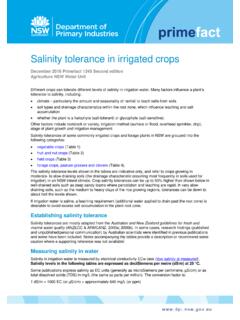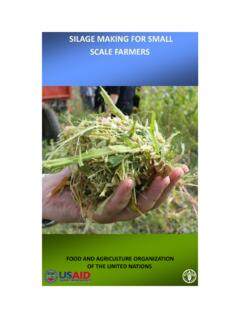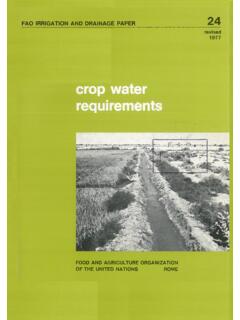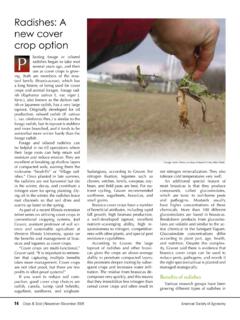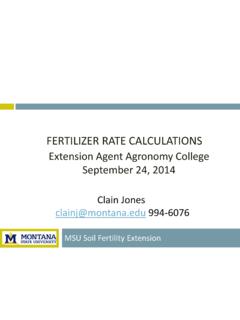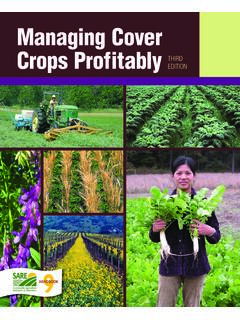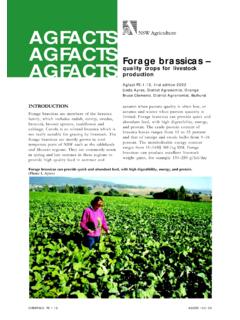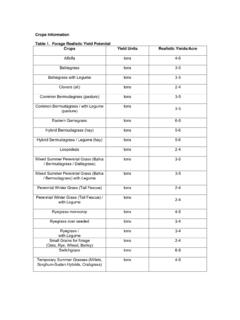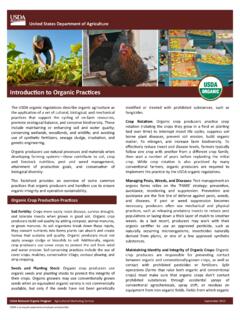Transcription of Environmental Impacts of Agricultural Technologies
1 NOTE: The findings and conclusions contained within this material are those of the authors and do not necessarily reflect positions or policies of the Bill & Melinda Gates Foundation. Page 1 Environmental Impacts of Agricultural Technologies EPAR Brief No. 65 Katherine Killebrew and Hendrik Wolff Prepared for the Agricultural Policy and Statistics Team Evans School Policy Analysis and Research (EPAR) of the Bill & Melinda Gates Foundation Professor Leigh Anderson, PI and Lead Faculty Associate Professor Mary Kay Gugerty, Lead Faculty March 17, 2010 Overview Ecosystem services are the benefits people obtain from ecosystems, such as provisioning of fresh water, food, feed, fiber, biodiversity, energy, and nutrient cycling.
2 Agricultural production can substantially affect the functioning of ecosystems, both positively and negatively. Growth in global food production over the past half century has required trade offs between ecosystem services, resulting in an overall decline in the supply of services other than food, feed, and The purpose of this report is to provide an overview of the Impacts of Agricultural Technologies and practices on ecosystem services such as soil fertility, water, biodiversity, air, and climate. Intensification allows farmers to obtain greater yields per unit time and area by planting more crops each year, specializing in repetitive cultivation of modern varieties, and using higher amounts of external The report describes the Environmental Impacts of different aspects of intensification in the following sections.
3 Table 1 contains a summary of Technologies and their Environmental Impacts . Section One describes the Impacts of intensive cropping practices, including monoculture, continuous cropping, conventional tillage, intensive livestock systems, and cultivation in fragile hillside areas. Section Two covers the Impacts of using inputs associated with intensification, such as inorganic fertilizers, pesticides, irrigation systems, and new seed varieties. Section Three exemplifies the Impacts of intensive cropping practices and inputs by examining intensive rice systems. Section Four extends the discussion from farming practices to examine the Impacts of industrial crop processing.
4 Although this report focuses on the Impacts of Agricultural practices on the environment, many of the practices also have implications for plant, animal, and human health. Farmers and others who come in contact with air, water, and soils polluted by chemical fertilizers and pesticides, for example, may face negative health consequences. By degrading components of the ecosystem, these practices affect the health of plants and animals living within the ecosystem. 1 Millennium Ecosystem Assessment, 2005, p. 27 2 Cassman & Pingali, 1995, p. 299 Page 2 Table 1. Overview of Agricultural Technologies and Impacts on ecosystem services Technology Impacts on Soils Impacts on WaterImpacts on Biodiversity Impacts on Air/Climate Case Example Monoculture Reduces habitat for insects and wildlife, leading to increased need for pesticides Reduced bird populations in monocropped coffee fields in Colombia and Mexico Continuous Cropping Soil fertility declines due to nutrient mining Reduces farmers' ability to use natural pest cycles.
5 Leading to increased need for pesticides Nutrient offtake in reduced fallow cassava farms in Kenya and Uganda Conventional Tillage Reduces soil organic matter, leading to increased erosion Contributes to CO2 emissions due to decomposition of soil organic matter Soil compaction due to tillage in maize fields in Nigeria Intensive Hillside Cultivation Increases erosion, leading to soil degradation Significant soil loss rates due to erosion in Ethiopian highlands Intensive Livestock Systems Increases erosion and soil compaction due to overgrazing and hoof action Untreated livestock waste degrades water quality.
6 Water usage competes with other needs Degrades grassland habitat due to overgrazing Contributes to CH4 and N2O emissions due to enteric fermentation and manure management Soil degradation and erosion caused by overgrazing in the Irangi Hills in TanzaniaInorganic Fertilizers Increases soil acidification due to nitrate leaching Reduces oxygen levels due to run-off, harming aquatic ecosystems; impairs water for human uses Contributes to smog, ozone, acid rain, and N2O emissions Eutrophic dead zones in the Baltic Sea, Black Sea, and west coast of India Pesticides Harms animal and human health by accumulating in soils and leaching into water bodies Use of unauthorized pesticide recipes in maize fields in Ethiopia Page 3 Irrigation Systems Inadequate drainage and over-irrigation causes waterlogging and salinization Degrades downstream ecosystems due to polluted run-off and over-extraction of water Shrinking of Aral Sea due to over-extraction for irrigation.
7 Particularly for cotton cultivation New Seed Varieties May increase need for inputs that negatively impact soils May increase need for inputs that negatively impact water quality and quantity Reduces maintenance of genetic diversity in landrace varieties May increase need for fertilizer, leading to increased greenhouse gas emissions Intensive Rice Production Inadequate drainage and continuous flooding causes waterlogging, salinization, and nutrient problems Degrades downstream ecosystems due to polluted run-off and over-extraction of water Contributes to CH4 emissions due to anaerobic conditions in paddy fields Over-extraction for rice irrigation in Tamil Nadu, India Industrial Crop Processing Degrades downstream ecosystems due to water requirements and discharge of untreated wastewater Contributes to CO2 emissions due to energy requirements of machinery Water pollution near coffee processing plants in Mexico Source: Compiled by Killebrew, 2010 Section One.
8 Intensive Cropping Practices Monoculture A key component of Agricultural intensification is monoculture, the cultivation of a single crop species in a field. Unlike traditional polyculture cropping configurations, which mix crop varieties or intersperse crops with trees or domesticated animals, monoculture allows farmers to specialize in crops that have similar growing and maintenance requirements. Farmers around the globe have increasingly adopted monoculture to achieve higher yields through economies of However, monoculture may negatively impact several scales of biodiversity. Impacts on Biodiversity: Monoculture systems provide a narrower range of habitat than polyculture fields, leading to an increased need for chemical pesticides.
9 3 Gliessman, 2000, p. 4 Page 4 Agricultural systems contain several dimensions of biodiversity. Planned biodiversity refers to the diversity of crops and animals chosen by a farmer for production, while associated biodiversity includes the micro-organisms, insects, birds, and other wildlife that both depend upon and help maintain ,5 By reducing planned biodiversity to include only one crop, monoculture affects the composition and abundance of associated biodiversity. For example, the balance of plant pests and their natural enemies that may exist in polyculture fields can be disrupted in monoculture systems, which provide habitat for a narrower range of Populations of bees, flies, moths, bats, and birds, which provide important pollinating and pest pressure services to crops, also tend to be lower in monocultures than in fields containing diverse forage and nesting For example, full-sun monocrop coffee fields in Colombia and Mexico have been found to support 90 percent fewer bird species than shade-grown coffee As a result of reduced biodiversity.
10 Monoculture systems have been found to be more susceptible than polycultures to insect infestation and plant viruses. Pingali & Rosegrant (1994), for example, found evidence of reduced rice yields throughout Southeast Asia due to increased pest populations in monoculture rice To manage pests in monoculture fields, farmers must apply chemical pesticides, leading to negative Impacts on water quality, wildlife populations, and human Continuous Cropping In addition to modifying spatial arrangements to increase production, farmers have made adjustments to the timing of growing practices to obtain more crops per Historically, farmers have alternated cultivation with long fallow periods or rotations with other crops to manage soil fertility.



